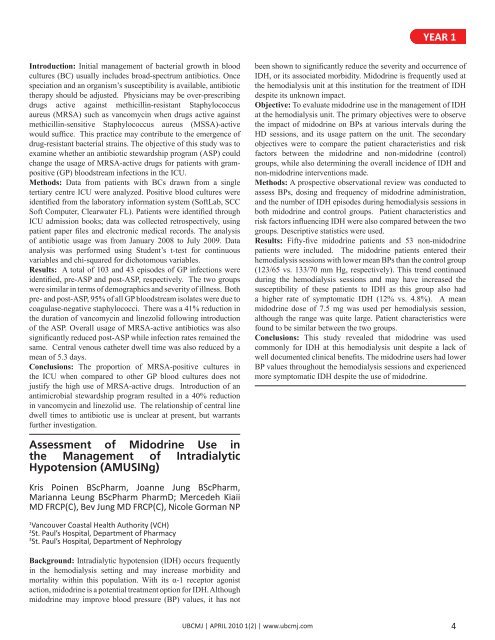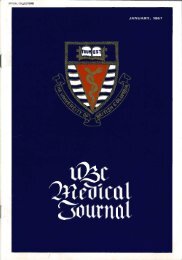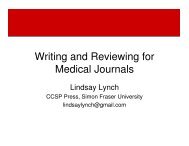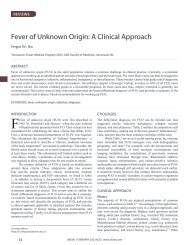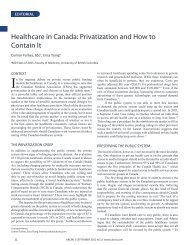Download full PDF - UBC Medical Journal
Download full PDF - UBC Medical Journal
Download full PDF - UBC Medical Journal
Create successful ePaper yourself
Turn your PDF publications into a flip-book with our unique Google optimized e-Paper software.
YEAR 1<br />
Introduction: Initial management of bacterial growth in blood<br />
cultures (BC) usually includes broad-spectrum antibiotics. Once<br />
speciation and an organism’s susceptibility is available, antibiotic<br />
therapy should be adjusted. Physicians may be over-prescribing<br />
drugs active against methicillin-resistant Staphylococcus<br />
aureus (MRSA) such as vancomycin when drugs active against<br />
methicillin-sensitive Staphylococcus aureus (MSSA)-active<br />
would suffice. This practice may contribute to the emergence of<br />
drug-resistant bacterial strains. The objective of this study was to<br />
examine whether an antibiotic stewardship program (ASP) could<br />
change the usage of MRSA-active drugs for patients with grampositive<br />
(GP) bloodstream infections in the ICU.<br />
Methods: Data from patients with BCs drawn from a single<br />
tertiary centre ICU were analyzed. Positive blood cultures were<br />
identified from the laboratory information system (SoftLab, SCC<br />
Soft Computer, Clearwater FL). Patients were identified through<br />
ICU admission books; data was collected retrospectively, using<br />
patient paper files and electronic medical records. The analysis<br />
of antibiotic usage was from January 2008 to July 2009. Data<br />
analysis was performed using Student’s t-test for continuous<br />
variables and chi-squared for dichotomous variables.<br />
Results: A total of 103 and 43 episodes of GP infections were<br />
identified, pre-ASP and post-ASP, respectively. The two groups<br />
were similar in terms of demographics and severity of illness. Both<br />
pre- and post-ASP, 95% of all GP bloodstream isolates were due to<br />
coagulase-negative staphylococci. There was a 41% reduction in<br />
the duration of vancomycin and linezolid following introduction<br />
of the ASP. Overall usage of MRSA-active antibiotics was also<br />
significantly reduced post-ASP while infection rates remained the<br />
same. Central venous catheter dwell time was also reduced by a<br />
mean of 5.3 days.<br />
Conclusions: The proportion of MRSA-positive cultures in<br />
the ICU when compared to other GP blood cultures does not<br />
justify the high use of MRSA-active drugs. Introduction of an<br />
antimicrobial stewardship program resulted in a 40% reduction<br />
in vancomycin and linezolid use. The relationship of central line<br />
dwell times to antibiotic use is unclear at present, but warrants<br />
further investigation.<br />
been shown to significantly reduce the severity and occurrence of<br />
IDH, or its associated morbidity. Midodrine is frequently used at<br />
the hemodialysis unit at this institution for the treatment of IDH<br />
despite its unknown impact.<br />
Objective: To evaluate midodrine use in the management of IDH<br />
at the hemodialysis unit. The primary objectives were to observe<br />
the impact of midodrine on BPs at various intervals during the<br />
HD sessions, and its usage pattern on the unit. The secondary<br />
objectives were to compare the patient characteristics and risk<br />
factors between the midodrine and non-midodrine (control)<br />
groups, while also determining the overall incidence of IDH and<br />
non-midodrine interventions made.<br />
Methods: A prospective observational review was conducted to<br />
assess BPs, dosing and frequency of midodrine administration,<br />
and the number of IDH episodes during hemodialysis sessions in<br />
both midodrine and control groups. Patient characteristics and<br />
risk factors influencing IDH were also compared between the two<br />
groups. Descriptive statistics were used.<br />
Results: Fifty-five midodrine patients and 53 non-midodrine<br />
patients were included. The midodrine patients entered their<br />
hemodialysis sessions with lower mean BPs than the control group<br />
(123/65 vs. 133/70 mm Hg, respectively). This trend continued<br />
during the hemodialysis sessions and may have increased the<br />
susceptibility of these patients to IDH as this group also had<br />
a higher rate of symptomatic IDH (12% vs. 4.8%). A mean<br />
midodrine dose of 7.5 mg was used per hemodialysis session,<br />
although the range was quite large. Patient characteristics were<br />
found to be similar between the two groups.<br />
Conclusions: This study revealed that midodrine was used<br />
commonly for IDH at this hemodialysis unit despite a lack of<br />
well documented clinical benefits. The midodrine users had lower<br />
BP values throughout the hemodialysis sessions and experienced<br />
more symptomatic IDH despite the use of midodrine.<br />
Assessment of Midodrine Use in<br />
the Management of Intradialytic<br />
Hypotension (AMUSINg)<br />
Kris Poinen BScPharm, Joanne Jung BScPharm,<br />
Marianna Leung BScPharm PharmD; Mercedeh Kiaii<br />
MD FRCP(C), Bev Jung MD FRCP(C), Nicole Gorman NP<br />
1<br />
Vancouver Coastal Health Authority (VCH)<br />
2<br />
St. Paul’s Hospital, Department of Pharmacy<br />
3<br />
St. Paul’s Hospital, Department of Nephrology<br />
Background: Intradialytic hypotension (IDH) occurs frequently<br />
in the hemodialysis setting and may increase morbidity and<br />
mortality within this population. With its α-1 receptor agonist<br />
action, midodrine is a potential treatment option for IDH. Although<br />
midodrine may improve blood pressure (BP) values, it has not<br />
<strong>UBC</strong>MJ | APRIL 2010 1(2) | www.ubcmj.com 4


